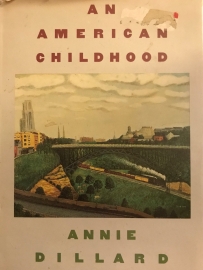
“What is important is anyone’s coming awake and discovering a place, finding in full orbit a spinning globe one can lean over, catch, and jump on. What is important is the moment of opening a life and feeling it touch–with an electric hiss and cry–this speckled mineral sphere, our present world.”
As a reader and writer of nature writing for the last two-plus decades, it’s no surprise anymore that new nature writing I experience, or those old classics I go back to again and again, include very little about women nature writers. Whether in quotes, commentary, discoveries, etc. For example, Ken Burns’ iconic National Parks documentary includes minimal interviews from women scientists and women in nature, and discusses male nature writers, discoverers, and politicians who had an effect on the outcome of those parks.
And in the late 1800s and early 1900s, it’s true that the majority of people out there exploring the American terrain and making decisions that still affect us and our awareness of landscape today, were men. When we think of nature writers, John Muir, Ralph Waldo Emerson, and Henry David Thoreau likely come to mind before anyone else. If we dig deeper and specifically think of women, Rachel Carson is probably the most well-known and revolutionary, with contemporaries like Cheryl Strayed and Helen Macdonald close behind.
A nature writer who has influenced a large part of my own writing is Annie Dillard. She may not have been out in the wilderness bearing zero-degree weather, or taking photographs in Alaska, or fighting the government to protect national parks, but she retold her own experiences in the natural world, while making important observations about the women who stayed home in the middle of the twentieth century.
In An American Childhood, Dillard describes her childhood through the outdoors, as if her childhood wouldn’t have been without nature, and as if nature wouldn’t have been without a child to explore it. She describes the unique thread of humanity with physical descriptions of the wild.
But she also touches on the woman’s role in the household, a part of growing up in America that she remembers deeply. She started to notice the differing professional options her mother and father had. She writes, “No page of any book described housework, and no one mentioned it; it didn’t exist. There was no such thing.”
Dillard understood how smart her mother was and saw too much potential behind the housework she had committed her life to.
“Mother’s energy and intelligence suited her for a greater role in a larger arena–mayor of New York, say–than the one she had… She saw how things should be run, but she had nothing to run but our household.”
To Dillard as a young child and into her adolescence, the world existed before her ready to be conquered and figured out and taken for granted. She wrote that “knowledge wasn’t a body, or a tree, but instead air, or space, or being–whatever pervaded, whatever never ended and fitted into the smallest cracks and the widest space between stars.”
She went on trips with her father to the Allegheny River, where he’d tell her about how things came to be in Pennsylvania, and she would explore the exciting landscape of discovery. “Crystals grew inside rock like arithmetical flowers. They lengthened and spread, adding plane to plane in awed and perfect obedience to an absolute geometry that even the stones–maybe only the stones–understood.”
She became obsessed with The Field Book of Ponds and Streams and says that she read “hoping to learn everything, so I could be like my father.”
So Dillard turned to writing. To observing and recording; not only the things she witnessed while lost in thought in the wilderness, but also the injustices she saw at home, recognizing that she didn’t want to end up as her mother had, as hard as it was, and is, to overcome that obstacle in the 60s and beyond.
“Some days I felt an urgent responsibility to each change of light outside the sunporch windows. Who would remember any of it, any of this our time, an the wind thrashing the buckeye limbs outside? Somebody had to do it, somebody had to hang on to the days with teeth and fists, or the whole show had been in vain.”
Meredith – if you haven’t heard of her, you should check out Mary Gibbs. She was Itasca State Park superintendent in early 1900’s.